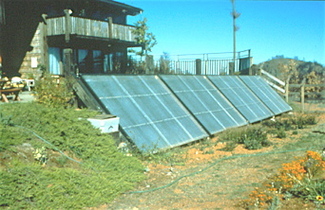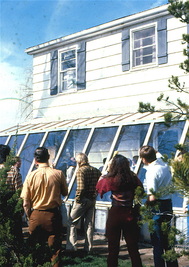Residential Solar Thermal Collection--
The technology of solar thermal energy conversion involves the placement of collection devices in the sunshine and use of (mostly liquids, sometimes air) to capture the converted heat, get it to storage, and hold it there for immediate or delayed distribution. This heat is utilized to heat space or hot water. The approaches to this job are varied and fall into two major categories. Active solar uses specialized collectors, pumps, fans, and storage systems to do this job. They are the "higher-tech" of the solar world. Passive solar takes an opposite approach. With passive, the building itself becomes the collector, the storage media, and the distribution device. There can even be a passive approach to water heating (but this, like active, faces challenges in freezing climates). There are purists within each technology, but either way, making the sun the origin of nearly all our residential heat demands is a unifying theme. More information on this subject (including video climps) can be found in the solar technology sub-menu in the Helpful Links page.
Click to explore
|
Click to explore
|


